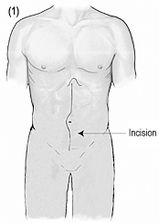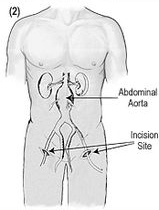
AAA Endograft Repair
Watch an animation about the Abdominal Aortic Aneurysm (AAA) Repair Procedure. *High Speed Internet Connection Required
An abdominal aortic aneurysm (AAA) occurs when a portion of the aorta passing through the abdomen is weakened and begins to bulge. This typically occurs in the region just below the kidneys.
The condition is fairly common in older adults and is more common in men than in women. Aneurysms are most often caused by atherosclerotic disease. Factors that may increase your risk for AAA include smoking, hypertension (high blood pressure), high cholesterol, Emphysema, obesity and genetic factors.
Abdominal Aortic Aneurysm Symptoms
Aneurysms may develop very slowly over many years, causing them to be asymptomatic. Certain patients with advanced cases of AAA may experience throbbing in the abdomen or lower back pain.
Because a large percentage of these cases are asymptomatic, many go undiagnosed, creating a life-threatening situation. Preventative screenings are critical in the detection and diagnosis of AAA so they can be appropriately managed and treated.
When abdominal aortic aneurysm symptoms are detected, consultation with one of our vascular surgeons is necessary to determine the appropriate method of treatment. Smaller aneurysms are usually monitored over time. Large aneurysms require treatment in order to prevent rupture. A ruptured aorta is life-threatening situation that requires immediate attention.
Abdominal Aortic Aneurysm Treatments
Treatment is usually not necessary until an aneurysm is more than 2 inches in diameter. (Normal abdominal aortic diameter is about one inch.) The procedure may be done in one of two ways:
- Standard “open” procedure involving an abdominal incision, or
- Minimally-invasive endovascular procedure using catheters that are inserted through the femoral arteries in the groin. In both cases, a graft (hollow synthetic tube) is inserted in place of the damaged artery. The placement of the graft either replaces the diseased portion of the aorta entirely or alleviates pressure on the weakening and bulging wall of the aorta, preventing rupture.
In a traditional open approach, the procedure is performed under general anesthesia. An incision is then made down the center of the abdomen and the muscles and internal organs are gently retracted to allow access to the aorta, which is located near the spine. The surgeon removes the damaged, weakened portion of the blood vessel and replaces it with the synthetic graft.
The Illustrations Shows the Surgical Repair of Abdominal Aortic Aneurysm



What is Endovascular Repair of AAA?

Recent technological advances allow our surgeons to perform a minimally-invasive endovascular procedure to treat/repair AAA. This approach uses a specially-designed graft that is placed inside the aneurysm. Rather than opening the abdomen, the graft is inserted to the aorta through two small incisions made in the femoral arteries, which are accessed through the groin. Thin tubes (catheters) are used to guide the graft through the aorta to the aneurysm site. The graft is then inflated at the site of the aneurysm and anchored to the normal, healthy artery above and below the diseased portion. This keeps the blood from pushing against the weakened arterial wall, which allows the aneurysm to slowly shrink back to near normal size over a period of four to six months.
Compared to open surgery, patients who undergo this endovascular stent-graft approach typically experience less blood loss, less pain, shorter recovery time and shorter hospital stays. CTVS surgeons discuss the risks and benefits of an endovascular approach with our patients to determine if they are an appropriate candidate.
Following Treatment
Patients undergoing an open surgical repair of an AAA typically stay in the hospital for about five to seven days following the surgery (including one or two days in the intensive care unit) and should expect full recovery within two months.
If an endovascular approach is used, patients should expect to remain in the hospital for two to three days following the procedure. Full recovery may take an additional week. Once treated, abdominal aortic aneurysms generally do not recur; however, annual follow ups will be required with your surgeon to ensure the graft remains in place as expected.
